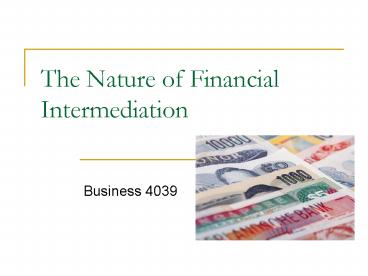The Nature of Financial Intermediation - PowerPoint PPT Presentation
1 / 16
Title:
The Nature of Financial Intermediation
Description:
Handout class problem presentations. News Current Events ... and time consuming and unsystematic process that can be prohibitively expensive. ... – PowerPoint PPT presentation
Number of Views:45
Avg rating:3.0/5.0
Title: The Nature of Financial Intermediation
1
The Nature of Financial Intermediation
- Business 4039
2
Today
- Questions course outline term papers
- Availability of texts who doesnt have a text?
- Handout class problem presentations
- News Current Events
- The Nature of Financial Intermediation
3
Key Concepts
- Pivotal role of banks and other deposit-taking
FIs - Rapid pace of change in markets, technologies and
non-bank competition - Information costs are responsible for emergence
of financial intermediaries - Financial intermediaries deal with
- Search
- Verification
- Monitoring
- Enforcement costs.
4
Important Terms Defined
- Liquidity and funding risk
- The threat of insufficient liquidity on the part
of the bank for normal operating requirements - Settlement/payment risk
- Is created when one party to a deal pays money or
delivers assets before receiving its own cash or
assets, hence exposing itself to a potential loss
and interest rate risk. - Interest rate risk
- The risk that arises from mismatches in both the
volume and maturity of interest-sensitive assets,
liabilities and off-balance sheet items - Market or price risk
- The exposure of banks to losses due to market or
price fluctuations in well-defined markets - Foreign exchange or currency risk
- The exposure of banks to fluctuations in foreign
exchange rates that affect positions held in a
particular currency for a customer or the bank. - Sovereign risk
- In which the political or economic conditions in
a particular country threaten to interrupt
repayment of loans or other debt obligations - Operating risk
- Arising from losses caused by fraud, failure of
internal control, or unexpected expenses, as in
the case of lawsuits.
5
Financial Intermediation
- Information is the underlying, core reason for
the existence of financial intermediaries. - Borrowers do not have the means to search out and
contract with lenders. Even if they do, it is
an expensive and time consuming and unsystematic
process that can be prohibitively expensive. - This situation does existfor example in the case
of angel capital.
6
Financial Intermediaries
- There are many types of financial intermediaries
that have evolved over time - Deposit-taking financial intermediaries
- Banks
- Trust companies
- Credit unions
- Non-depositor
- Life and PC insurance companies
- Investment dealers Task Force on the Future of
Financial Services - Finance Companies
- Other
- Mutual funds
20
K. Hartviksen
7
Uniqueness Recognized
- One of the themes dominating FI organization in
Canada is the degree to which the specialness of
Fis should be enshrined in law and regulatory
practice. - The end result is that financial institutions are
among the most heavily regulated and heavily
taxed organizations in our society. - You are encouraged to follow the current debates
on this topic in the financial press. Look for - deposit taking FI regulation
- insurance company regulation
- securities industry regulation
- Bank of Canada policy concerning FIs
- CDIC policy concerning FIs
- Regulatory activities of liability insurers
- international coordination of FI regulation
21
K. Hartviksen
8
Intermediation Services of FIs
- risk transfer, reduction, and monitoring services
- liquidity services
- maturity intermediation services
- transaction services
- financial information services
- denomination intermediation (mutual funds)
22
K. Hartviksen
9
Deficit-Saving Economic Unit
Surplus-Saving Economic Unit
- Borrowers
- borrow large sums
(mortgages/commercial/ personal loans) - for long periods of time
- complex legal transactions because of the
long-term nature of the debt contracts and the
need to contractually ensure that the interests
of the lender are protected.
- Savers
- many of them saving small amounts individually,
but large amounts in aggregate - for short periods of time (ie. Need liquidity)
- are generally risk averse
- dont have the capacity, time or sophistication
to analyze risk or to monitor borrowers
Deposit-taking Financial Intermediary
23
K. Hartviksen
10
Deficit-Saving Economic Unit
Surplus-Saving Economic Unit
Deposit-taking Financial Intermediary
- Deposit-taking FIs
- pool deposits, provide liquidity for depositors,
collect/analyze/monitor the financial
positions/activities of borrowers, make credit
allocation decisions among opportunities to
lend/invest, negotiate/monitor/enforce loan
agreements. - In this manner the need of both savers and
borrowers are met with efficiency. In the
absence of FIs failure, confidence in the system
is built and this encourages full participation,
thereby reducing monetary leakage.currency in
circulation is made available for the best
competing uses in our society.
24
K. Hartviksen
11
Price Risk
- the risk that the sale price of an asset will be
lower than its purchase price.
26
K. Hartviksen
12
Secondary Claims
- example demand deposit in a deposit-taking FI
- it is a financial asset that has characteristics
far different than primary securities (bonds,
stocks, commercial loans) gt often improved
liquidity/safety of principal, etc.
30
K. Hartviksen
13
Maturity Intermediation
- a service performed by deposit-taking FIs for
secondary asset holders (depositors)....because
of pooling and diversification.... - mismatching the maturities of assets and
liabilities of the FI.
31
K. Hartviksen
14
Securitization
- The creation of a marketable financial asset
through financial innovationof otherwise
illiquid financial assets - Eg. MBSs
15
Economies of Scale
- FIs provide potential economies of scale in
transactions costs...information collection and
risk management.
32
K. Hartviksen
16
Institutional Aspects of Special-ness
- money supply transmission (banks)
- credit allocation (banks, trusts, credit unions,
and finance companies) - risk offlay (insurance companies)
- intergenerational transfer (pensions, life
insurance companies, and deposit-taking FIs) - payment services (banks, trusts, and credit
unions) - denomination intermediation (mutual funds,
pension funds)
33
K. Hartviksen































